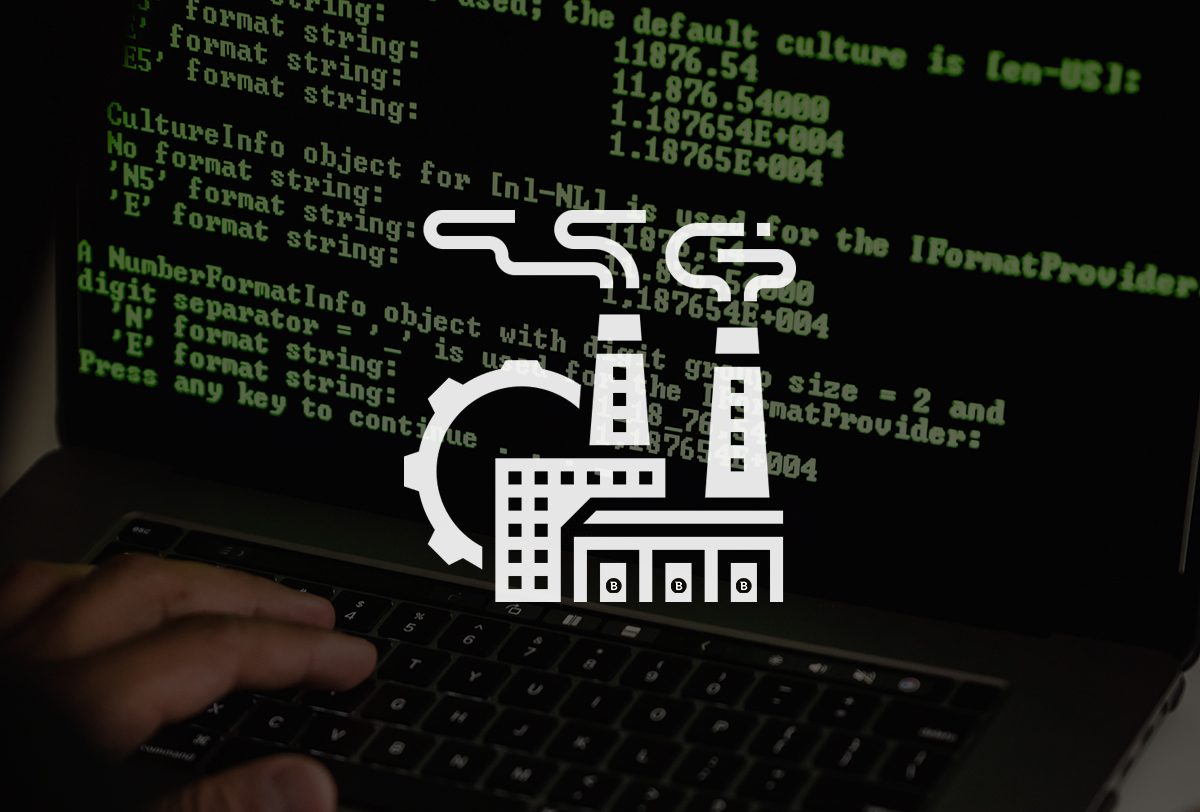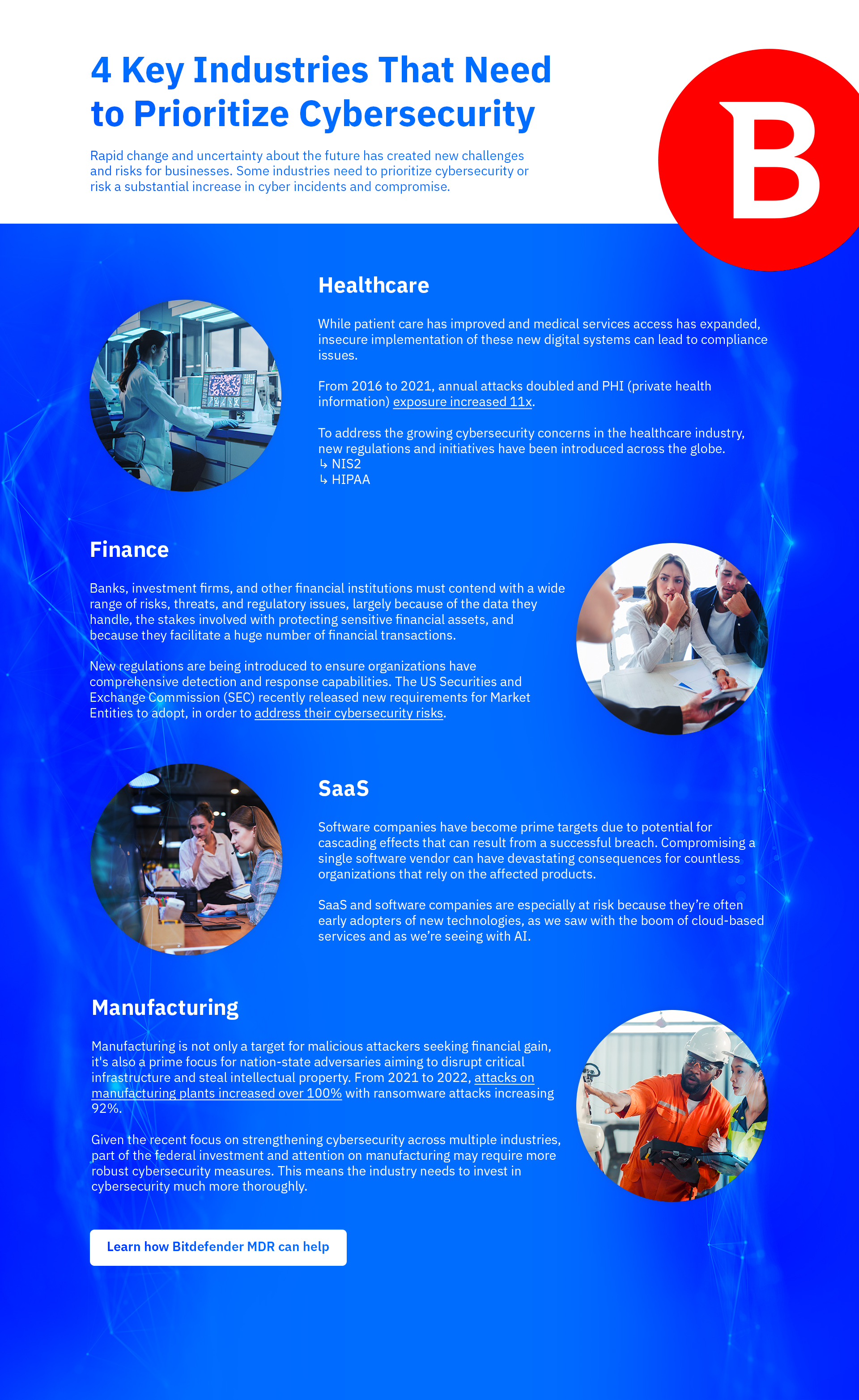4 Key Industries That Need to Prioritize Cybersecurity

The cybersecurity industry is undergoing a significant shift as it’s finding its way to adapt to a post-pandemic world. Over the past few years, industries accelerated their digital transformation efforts, increased their reliance on remote work, and leveraged cloud-based services on a greater scale. This rapid change, alongside lingering uncertainty about the future, has created new challenges and risks for businesses. Given these new complications, it’s increasingly clear that some industries need to prioritize cybersecurity or else risk an outsized increase in cyber incidents and compromises.
The risks these industries face are due to a myriad of internal, threat-based, and environmental factors. For example, the industries that have faced rapid growth and increased digital adoption in recent years may have gaps in security protocols, while others are facing increased targeting from malicious actors. For many companies, the growing interconnectivity and reliance on global supply chains have created additional vulnerabilities that have yet to be addressed.
We’ve identified four industries that need to prioritize cybersecurity the most: healthcare, finance, SaaS and software, and manufacturing. In this article, we’ll delve into the unique cybersecurity concerns each industry faces and what solutions they may be able to utilize.
Healthcare: A Prime Target for Cyber Threats
Hospitals, clinics, and other healthcare providers often rely on interconnected systems to manage patient data, medical records, and other critical information. In an effort to streamline services and because of the pandemic, this industry experienced a striking digital transformation, experiencing a surge in digital initiatives, telehealth services, and the utilization of IoT devices.
At the same time, these advancements have further increased the attack surface, creating an environment where devices or systems have become prime targets for cybercriminals seeking to exploit vulnerabilities and extort money from organizations that cannot afford downtime or data loss. From 2016 to 2021, annual attacks doubled and PHI (private health information) exposure increased 11x.
While patient care has improved and medical services access has expanded, insecure implementation of these new digital systems can also lead to non-compliance issues. To address the growing cybersecurity concerns in the healthcare industry, new regulations and initiatives have been introduced across the globe.
These include the European Union's NIS 2 Directive, which seeks to mandate a stronger cybersecurity posture, better breach notice, and enforcing more severe fines for non-compliance.This new regulation affects healthcare facilities as well as device manufacturers HIPAA has also updated their guidance and requirements to better address digital security concerns and the widespread use of digital health records and telehealth.
Finance: High-Stakes and High-Risk
Banks, investment firms, and other financial institutions must contend with a wide range of risks, threats, and regulatory issues that can arise from cybersecurity incidents, largely because of the data they handle, the stakes involved with protecting sensitive financial assets, and because they facilitate a huge number of financial transactions. The high profile turmoil involving banks such as Silicon Valley Bank (SVB) and First Republic are also creating a riskier environment where scammers are looking to jump on the uncertainty.
This makes the finance industry at risk of ransomware attacks, which can bring down operations, causing havoc on financial systems. The industry is also overexposed to business email compromise (BEC) attacks. These attacks often involve cybercriminals impersonating executives or other high-ranking individuals to trick employees into transferring funds or revealing sensitive information.
In response to the increasing cybersecurity risks in the finance industry, new regulations are being introduced to ensure organizations have comprehensive detection and response capabilities. The US Securities and Exchange Commission (SEC) recently released new requirements for Market Entities to adopt, in order to address their cybersecurity risks
SaaS/Software: Frontline of Digital Innovation and Cyber Risk
The SaaS and software industry finds itself at the forefront of digital innovation, serving as the software supply chain, putting it squarely in the crosshairs of cybercriminals and nation-state attackers. Software companies have become prime targets due to the potential for far-reaching and cascading effects that can result from a successful breach. As seen in recent high-profile attacks, compromising a single software vendor can have devastating consequences for countless organizations that rely on the affected products.
In April 2023, hackers targeted 3CX, a well known B2B video conferencing app. It compromised the desktop app, allowing it to drop malware on users who had 3CX installed. Given the company’s wide-reaching user base, hackers knew they could leverage a single company to compromise thousands more.
SaaS and software companies are especially at risk because they’re often early adopters of new technologies, as we saw with the boom of cloud-based services and as we’re seeing with AI. While this drive for innovation can lead to competitive advantages and improved services, it can expose the industry to emerging threats and vulnerabilities that may not yet be well understood.
Being an industry made up of a large share of newcomers and start ups, they’re more likely to experience resource constraints and tightened budgets while dealing with the growing skills gap in cybersecurity. Balancing the need for robust security measures with financial and human resource limitations can be challenging, but it is essential for these companies as their cybersecurity posture increasingly becomes a critical factor when considering potential acquisition deals, raising VC funds, and exploring potential sales. Prospective partners, investors, and customers are more likely to trust and engage with companies that are prioritizing and investing in their cybersecurity.
Manufacturing: Navigating the Digital Transformation and Emerging Risks
The manufacturing industry is currently in the midst of modernizing its supply chain and production processes, largely through digital transformation and adopting cloud-based services, products, and systems. However, as we saw with healthcare, if cybersecurity and risk management isn’t considered, this new digital expansion also carries a high amount of risk that reduces a company’s security posture and makes them more susceptible to cyber attacks, vulnerabilities, and accidental incidents.
Manufacturing is not only a target for malicious attackers seeking financial gain, but it is also a prime focus for nation-state adversaries aiming to disrupt critical infrastructure and steal intellectual property. From 2021 to 2022, attacks on manufacturing plants increased over 100% with ransomware attackers increasing 92%.
The recent push by the Biden administration to bring microchip manufacturing back to the country signals a possible resurgence in manufacturing, and will likely be accompanied by increased investment and attention from both public and private sectors. However, this growth comes with its own set of challenges, and it’s hard to see how the skills gap will be addressed as the manufacturing industry grows.
This may result in a newfound industry that has insufficient cybersecurity, vulnerable devices, and misconfigured systems, leaving it exposed to potential attacks, stifling growth and affecting the overall impact the industry may have on the country. Given the recent focus on strengthening cybersecurity across multiple industries, part of the federal investment and attention on manufacturing may require more robust cybersecurity measures. This means the industry needs to invest in cybersecurity much more thoroughly.
How MDR and XDR Can Help These Industries Overcome Cybersecurity Challenges
The skills gap is a pervasive issue that affects all industries, particularly the ones we focused on in this article. In response, cybersecurity vendors are offering outsourced managed services in the form of Managed Detection and Response (MDR) and Extended Detection and Response (XDR), among others. These services provide access to skilled cybersecurity professionals 24/7 allowing organizations to strengthen their security posture, proactive threat hunt, and respond quickly in the case of an attack without needing to invest in additional in-house talent.
Building an in-house security team and infrastructure can take months or even years to develop, which can be too long in the face of increasing regulatory and environmental pressures. By relying on these managed services, the time to cybersecurity is dramatically shortened, minimizing the exposure these high-risk industries have to potential breaches and attacks.
For healthcare organizations, it means protecting patient data and ensuring compliance with updated and new regulations introduced by HIPAA and NIS 2. In the finance sector, they can more confidently safeguard financial assets and adhere to evolving SEC regulations. Software and SaaS companies can leverage a strong cybersecurity posture to enhance trust and facilitate business opportunities while the manufacturing industry can secure critical infrastructure and intellectual property while advancing their own industry to a more optimized state.
MDR and XDR services also optimize resources for organizations facing tightened budgets by being cost-effective options designed to streamline your cybersecurity department via vendor consolidation, automating manual tasks, and saving up your internal team’s time. This allows companies across all industries to allocate their resources more efficiently and focus on their core business operations, knowing that their cybersecurity is being handled by trusted experts.
By adopting MDR and XDR services, organizations in these high-risk industries can overcome the cybersecurity challenges they face in the post-pandemic world and continue to thrive in an increasingly interconnected and digital environment.
Contact an Expert and Learn More About Bitdefender Managed Detection and Response
tags
Author

Josue Ledesma is a writer, filmmaker, and content marketer living in New York City. He covers cyber security, tech and finance, consumer privacy, and B2B digital marketing.
View all postsRight now Top posts
FOLLOW US ON SOCIAL MEDIA
SUBSCRIBE TO OUR NEWSLETTER
Don’t miss out on exclusive content and exciting announcements!
You might also like
Bookmarks









